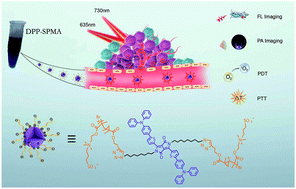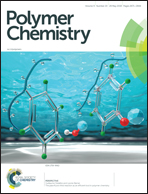Zwitterionic diketopyrrolopyrrole for fluorescence/photoacoustic imaging guided photodynamic/photothermal therapy†
Abstract
Dual-modal imaging and dual-modal therapy provide multiple complementary theranostic features. The theranostic agent has favorable renal excretion and low cytotoxicity, making it of great interest in the nanomedical field. Herein, a water-soluble conjugated zwitterionic polymer (DPP-SPMA) with low-fouling and low cytotoxicity was prepared and used for fluorescence/PA imaging guided PTT/PDT therapy. The in vivo imaging results showed that the DPP-SPMA had excellent enhanced permeability and retention effects. The fluorescence imaging demonstrated that the DPP-SPMA was excreted by renal metabolism because the controlled molecular mass was less than the renal filtration threshold. The DPP-SPMA shows a photothermal effect under 730 nm irradiation and an excellent singlet oxygen generation capacity for the PDT therapy under 635 nm irradiation. The high accumulation of DPP-SPMA by passive targeting around the tumor stimulated excellent synergistic photodynamic therapy and photothermal therapy. As a result, the water-soluble zwitterion DPP-SPMA was well suited for fluorescence/PA dual-modal imaging and had significant antitumor activity in vivo via synergistic photodynamic therapy and photothermal therapy.



 Please wait while we load your content...
Please wait while we load your content...